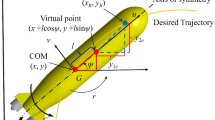Abstract
Remotely operated underwater vehicle (ROUV) provides an interesting and extensible platform to search the wanted objects and for the inspection of deep sea. The basic goal of this research is to control the position and stabilize the dynamic behavior of ROUV. In this study, we design the dual controller approach design for controlling the overall responses of ROUV. The design dual controller consists of model reference adaptive control (MRAC) along with proportional integral derivative (PID) controller and an integral use for the feedback of the design scheme. The dynamic moments and disturbances in the system is dealt by MRAC controller and PID controller is responsible for tuning the adaptive gains of the system. However, Lyapunov stability criterion is responsible for the stability of the system. The inclusion of integrator as a feedback in the system increases the order of the system model, but it helps to eliminate the steady state error and also improves the convergence rate of the system. The designed control algorithm is tested and confirmed its validity using experiment and simulations by tracking the reference path of the ROUV. It is evidence that the designed control system shows quick convergence, improved steady state error and better robustness in the presence of disturbances.












Similar content being viewed by others
References
Antonelli, G. (2014). Underwater robots (Vol. 3). Switzerland: Springer.
Christ, R. D., & Wernli, R. L., Sr. (2013). The ROV manual: a user guide for remotely operated vehicles. Oxford: Butterworth-Heinemann.
Leonard, J. J., & Bahr, A. (2016). Autonomous underwater vehicle navigation. Springer handbook of ocean engineering (pp. 341–358). Cham: Springer.
Li, De-jun, Chen, Yan-hu, Shi, Jian-guang, & Yang, Can-jun. (2015). Autonomous underwater vehicle docking system for cabled ocean observatory network. Ocean Engineering, 109, 127–134.
Myint, M., Yonemori, K., Yanou, A., Ishiyama, S., & Minami, M. (2015) Robustness of visual-servo against air bubble disturbance of underwater vehicle system using three-dimensional marker and dual-eye cameras.” In OCEANS 2015-MTS/IEEE Washington, pp. 1–8. IEEE.
Yordanova, Veronika. (2018). Intelligent adaptive underwater sensor networks. PhD diss.: UCL (University College London).
Phillips, M., & Michaud, M. (2018) Trace evidence preservation during underwater body recovery.
Utne, Ingrid B., Schjølberg, Ingrid, & Roe, Emery. (2019). High reliability management and control operator risks in autonomous marine systems and operations. Ocean Engineering, 171, 399–416.
Alshamrani, O. S. D., & Saleem, M. (2017) Use of unmanned aerial vehicles for surveillance and security of border areas and cities.” Border Security and Safety (2017): 144.
Kydd, K., Macrez, S., & Pourcel, A. (2015) Autonomous robot for gas and oil sites. In SPE Offshore Europe Conference and Exhibition. Society of Petroleum Engineers.
Hassene, R., & Makhlouf, M. (2017) Advanced technologies for marine border security. Border Security and safety (2017): 112.
Berlinger, Florian, Dusek, Jeff, Gauci, Melvin, & Nagpal, Radhika. (2017). Robust maneuverability of a miniature, low-cost underwater robot using multiple fin actuation. IEEE Robotics and Automation Letters, 3(1), 140–147.
Xu, J., & Wang, N. (2018) Optimization of ROV control based on genetic algorithm. In 2018 OCEANS-MTS/IEEE Kobe Techno-Oceans (OTO), pp. 1–4. IEEE.
Salumäe, Taavi, Chemori, Ahmed, & Kruusmaa, Maarja. (2017). Motion control of a hovering biomimetic four-fin underwater robot. IEEE Journal of Oceanic Engineering, 99, 1–18.
Van Hien, N., Van He, N., & Diem, P. G. (2018). A model-driven implementation to realize controllers for Autonomous underwater vehicles. Applied Ocean Research, 78, 307–319.
Rúa, S., & Vásquez, R. E. (2016). Development of a low-level control system for the ROV Visor3. International Journal of Navigation and Observation. https://doi.org/10.1155/2016/8029124.
Healey, Antony J. (1992). Model-based maneuvering controls for autonomous underwater vehicles. Journal of Dynamic Systems, Measurement, and Control, 114(4), 614–622.
Khadhraoui, A., Beji, L., Otmane, S., & Abichou, A. (2013) Explicit homogeneous time-varying stabilizing control of a submarine vehicle (ROV).” In 10th International Conference on Informatics in Control, Automation and Robotics (ICINCO 2013), vol. 1, pp. 26–32.
Lavretsky, E.,& Wise, K. A. (2013) Model reference adaptive control with integral feedback connections. In Robust and Adaptive Control (pp. 293–315). Springer, London
Ali, Z. A., Li, X., & Tanveer, M. A. (2019). Controlling and stabilizing the position of remotely operated underwater vehicle equipped with a gripper. Wireless Personal Communications. https://doi.org/10.1007/s11277-019-06938-2.
Acknowledgement
The above research is dedicated to Professor Li Xinde, School of Automation Engineering, South-East University, Nanjing, Jiangsu, China.
Funding
This work was supported in part by the National Natural Science Foundation of China under Grant 61573097 and 91748106, in part by Key Laboratory of Integrated Automation of Process Industry (PAL-N201704), in part by the Fundamental Research Funds for the Central Universities (3208008401), in part by the Qing Lan Project and Six Major Top-talent Plan, and in part by the Priority Academic Program Development of Jiangsu Higher Education Institutions.
Author information
Authors and Affiliations
Corresponding author
Additional information
Publisher's Note
Springer Nature remains neutral with regard to jurisdictional claims in published maps and institutional affiliations.
Rights and permissions
About this article
Cite this article
Ali, Z.A., Li, X. & Noman, M. Stabilizing the dynamic behavior and Position control of a Remotely Operated Underwater Vehicle. Wireless Pers Commun 116, 1293–1309 (2021). https://doi.org/10.1007/s11277-020-07378-z
Published:
Issue Date:
DOI: https://doi.org/10.1007/s11277-020-07378-z




